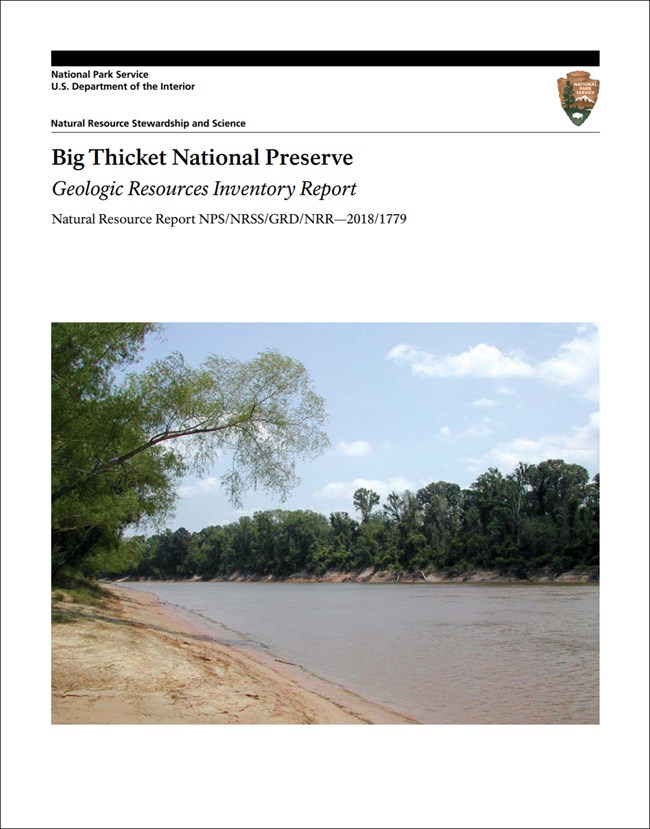Last updated: June 17, 2024
Article
NPS Geodiversity Atlas—Big Thicket National Preserve, Texas
Geodiversity refers to the full variety of natural geologic (rocks, minerals, sediments, fossils, landforms, and physical processes) and soil resources and processes that occur in the park. A product of the Geologic Resources Inventory, the NPS Geodiversity Atlas delivers information in support of education, Geoconservation, and integrated management of living (biotic) and non-living (abiotic) components of the ecosystem.

Introduction
Big Thicket National Preserve (BITH) consists of nine individual land units and six water corridors located just north of Beaumont, approximately 120 km (75 mi) from downtown Houston in Hardin, Jasper, Jefferson, Liberty, Orange, Polk, and Tyler Counties, Texas. Authorized on October 11, 1974, BITH encompasses about 44,147 hectares (109,092 acres) and protects remnants of “the Big Thicket”, a biologically diverse region of southeastern Texas situated at the crossroads of several major biomes that include Eastern hardwood forest, Gulf coastal plains, Midwest prairies, and southwest deserts (National Park Service 2014a, 2016a). The preserve landscape is dominated by a dynamic hydrologic system that is at least 40% wetlands and features floodplains, oxbow lakes, sloughs, bogs, and tributary streams. Riparian regions of BITH support numerous species of birds, amphibians, reptiles, and mammals while also preventing floods and improving water quality conditions. The Big Thicket once covered more than 1.2 million hectares (3 million acres), but widespread logging and oil production since the late 19th century has reduced the ecological system to approximately 10% of its original area (Thornberry-Ehrlich 2018). The segments of the Big Thicket that make up BITH represent the first national preserve designation in the National Park System. The rich biodiversity of the preserve is internationally recognized, and BITH has been designated a United Nations Educational, Scientific and Cultural Organization (UNESCO) Biosphere Reserve in 1981, as well as an American Bird Conservancy Globally Important Bird Area in 2001.
Geologic Setting
BITH is situated in the Coastal Plain physiographic province of southeast Texas, a region underlain by a thick accumulation of hydrocarbon-rich strata dating back to the Triassic Period approximately 250 million years ago (Durham and Murray 1967; McBride et al. 1989; Harry and Londono 2004). The geology of BITH is comprised of much younger, Cenozoic sedimentary strata, with the oldest bedrock consisting of the Miocene (23 to 5.3 million years ago) Fleming Formation that occurs in the upper reaches of the Neches River and Big Sandy Creek within the preserve. Several Pleistocene formations of dominantly fluvial and deltaic origin underlie BITH and include gravel, sandstone, siltstone, and mudstone deposits of the Willis Formation, Lissie Formation, Beaumont Alloformation, and Deweyville Formation (Chowdhury and Turco 2006). The youngest rocks mapped within BITH are unconsolidated Holocene surficial deposits that occur in association with the floodplains and tributaries of the Neches River, Pine Island Bayou, and Village Creek.
Regional Geology
Big Thicket National Preserve is a part of the Coastal Plain Physiographic Province and shares its geologic history and some characteristic geologic formations with a region that extends well beyond park boundaries.
- Scoping summaries are records of scoping meetings where NPS staff and local geologists determined the park’s geologic mapping plan and what content should be included in the report.
- Digital geologic maps include files for viewing in GIS software, a guide to using the data, and a document with ancillary map information. Newer products also include data viewable in Google Earth and online map services.
- Reports use the maps to discuss the park’s setting and significance, notable geologic features and processes, geologic resource management issues, and geologic history.
- Posters are a static view of the GIS data in PDF format. Newer posters include aerial imagery or shaded relief and other park information. They are also included with the reports.
- Projects list basic information about the program and all products available for a park.
Source: NPS DataStore Saved Search 3411. To search for additional information, visit the NPS DataStore.
A NPS Soil Resources Inventory project has been completed for Big Thicket National Preserve and can be found on the NPS Data Store.
Source: NPS DataStore Saved Search 3410. To search for additional information, visit the NPS DataStore.


